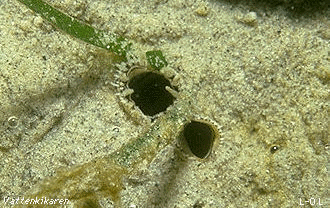|

Environment
|
|
More about the cockle
Environment
The Common cockle is quite widespread
in northern Europe, especially on sandy beaches within tidal
areas. The cockles siphons can be seen as two small shining marks in the
sand. The cockle, with its long and powerful foot, ploughs its way through
the sand leaving a furrow afterwards. If it should find itself on top
of the sand, it is able to dig downwards quickly because of the foots
curveture, which enables the cockle to pull itself downwards. Compare
with how other beach organisms dig.
If, on a summers day, a number of cockles are placed in
the water above the sand, many of them will probably have dug down into
the sand within a few minutes, and nearly all of them within 10 minutes.
Young cockles dig faster than adults, and dig faster during the summer
compared to the winter. Despite the dangers of ice and cold, the cockle
can survive in a frozen sand bottom up to a month.

The siphons of a Common cockle seen from above. The
inhalent is on the left, while the narrow exhalent is on the right.
The rest of the cockle is hidden in the sand. The green weed is eel
grass .
|
|
Page
1 of 3
|

|
|